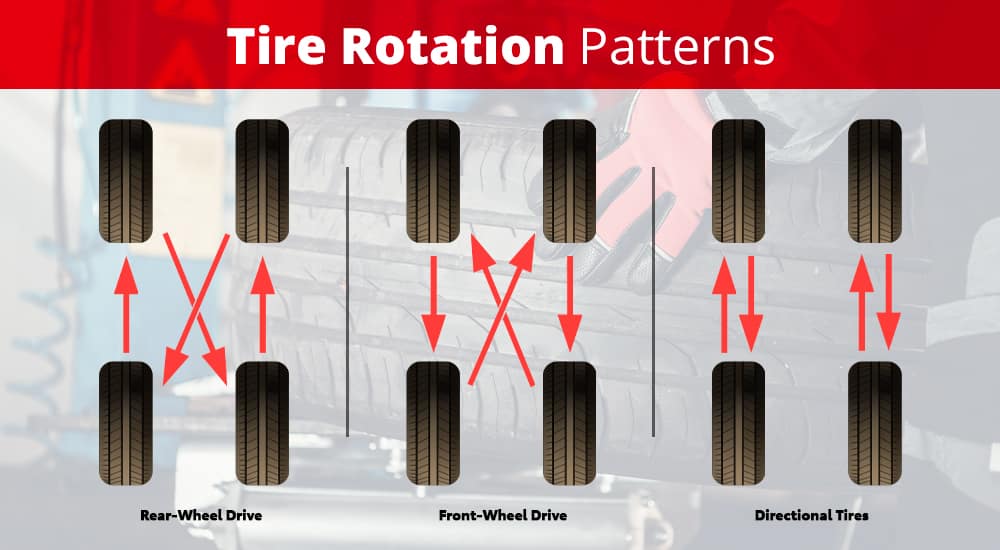Tire rotation, that is routinely repositioning your vehicle’s tires in specific patterns from front to back or side to side, is an important element of tire upkeep and safety. Additionally, rotating your tires may also be required to keep your tires covered under warranty. For a quick visual summary of tire rotation, check out our Tread Life episode about tire rotation. Read on for more information about what tire rotation is, why tire rotation patterns matter, and the correct pattern for your vehicle’s needs.
Find Your Bridgestone Service Center
Tire rotation means periodically changing the position of each of the tires on your vehicle. You should rotate your tires as recommended by the vehicle manufacturer, or every 5,000 miles. For many of you, that will mean when you get your vehicle’s oil changed.
Regularly rotating your tires also gives you a good opportunity to visually inspect them for damage, check their air pressure, have them rebalanced if you’re noticing any vibration, and check their tread depth.
There are several reasons why tire rotation is an important element of your standard tire care. First, by routinely rotating your tires, wear is spread evenly across all four tires, and their tread life is maximized. That’s because each specific position on your vehicle requires a different give from each tire—(for example, tires on the front of a front-wheel drive vehicle will take a larger proportion of the torque and friction that’s needed for turning, accelerating and braking)—and can lead to more, or less, wear on the tire. It is especially important to rotate new tires by 5,000 miles because deep, fresh tire tread is more susceptible to uneven wear.
Secondly, even tread wear keeps the tread depth on your tires uniform, which can help keep traction and handling consistent across all four tires. This will improve cornering and braking performance and keep your vehicle safer for driving overall.
Finally, if your vehicle has all-wheel-drive, evenly worn tires lower the stresses on the drivetrain, reducing wear on expensive drive components.
For those looking for a luxury tire experience
See Tire Details This Tire Fits Your Vehicle See a map of stores near you where you can buy this tire
See Tires That Fit Does Not Fit Your Vehicle
See if it Fits Not Sure If This Tire Fits
80,000 miles of quiet, comfort and control*
See Tire Details This Tire Fits Your Vehicle See a map of stores near you where you can buy this tire
See Tires That Fit Does Not Fit Your Vehicle
See if it Fits Not Sure If This Tire Fits
Keep your life on a roll
See Tire Details This Tire Fits Your Vehicle See a map of stores near you where you can buy this tire
See Tires That Fit Does Not Fit Your Vehicle
See if it Fits Not Sure If This Tire Fits
All-season tires that won't stop until they get you there
See Tire Details This Tire Fits Your Vehicle See a map of stores near you where you can buy this tire
See Tires That Fit Does Not Fit Your Vehicle
See if it Fits Not Sure If This Tire Fits
Confident all-weather protection
See Tire Details This Tire Fits Your Vehicle See a map of stores near you where you can buy this tire
See Tires That Fit Does Not Fit Your Vehicle
See if it Fits Not Sure If This Tire Fits
Drive more and fill up your tank less*
See Tire Details This Tire Fits Your Vehicle See a map of stores near you where you can buy this tire
See Tires That Fit Does Not Fit Your Vehicle
See if it Fits Not Sure If This Tire Fits
Extended mobility PLUS improved performance through the elements
See Tire Details This Tire Fits Your Vehicle See a map of stores near you where you can buy this tire
See Tires That Fit Does Not Fit Your Vehicle
See if it Fits Not Sure If This Tire Fits
Built for your truck, SUV, or CUV
See Tire Details This Tire Fits Your Vehicle See a map of stores near you where you can buy this tire
See Tires That Fit Does Not Fit Your Vehicle
See if it Fits Not Sure If This Tire Fits
Tough enough to take a puncture*
See Tire Details This Tire Fits Your Vehicle See a map of stores near you where you can buy this tire
See Tires That Fit Does Not Fit Your Vehicle
See if it Fits Not Sure If This Tire Fits
Tires that take you on a thrill ride
See Tire Details This Tire Fits Your Vehicle See a map of stores near you where you can buy this tire
See Tires That Fit Does Not Fit Your Vehicle
See if it Fits Not Sure If This Tire Fits
Ready for heavy-duty hauls
See Tire Details This Tire Fits Your Vehicle See a map of stores near you where you can buy this tire
See Tires That Fit Does Not Fit Your Vehicle
See if it Fits Not Sure If This Tire Fits
High performance driving all year long
See Tire Details This Tire Fits Your Vehicle See a map of stores near you where you can buy this tire
See Tires That Fit Does Not Fit Your Vehicle
See if it Fits Not Sure If This Tire Fits
Handle it all in your high performance CUV or SUV
See Tire Details This Tire Fits Your Vehicle See a map of stores near you where you can buy this tire
See Tires That Fit Does Not Fit Your Vehicle
See if it Fits Not Sure If This Tire Fits
Ready for the long haul
See Tire Details This Tire Fits Your Vehicle See a map of stores near you where you can buy this tire
See Tires That Fit Does Not Fit Your Vehicle
See if it Fits Not Sure If This Tire Fits
Built to keep you and your workload going
See Tire Details This Tire Fits Your Vehicle See a map of stores near you where you can buy this tire
See Tires That Fit Does Not Fit Your Vehicle
See if it Fits Not Sure If This Tire Fits
Built for the demands of commercial highway driving
See Tire Details This Tire Fits Your Vehicle See a map of stores near you where you can buy this tire
See Tires That Fit Does Not Fit Your Vehicle
See if it Fits Not Sure If This Tire Fits
View All Season Tires
For those looking for a luxury tire experience
See Tire Details This Tire Fits Your Vehicle See a map of stores near you where you can buy this tire
See Tires That Fit Does Not Fit Your Vehicle
See if it Fits Not Sure If This Tire Fits
Keep your life on a roll
See Tire Details This Tire Fits Your Vehicle See a map of stores near you where you can buy this tire
See Tires That Fit Does Not Fit Your Vehicle
See if it Fits Not Sure If This Tire Fits
Built for your truck, SUV, or CUV
See Tire Details This Tire Fits Your Vehicle See a map of stores near you where you can buy this tire
See Tires That Fit Does Not Fit Your Vehicle
See if it Fits Not Sure If This Tire Fits
Take on the intensity of on and off road driving
See Tire Details This Tire Fits Your Vehicle See a map of stores near you where you can buy this tire
See Tires That Fit Does Not Fit Your Vehicle
See if it Fits Not Sure If This Tire Fits
Tires that take you on a thrill ride
See Tire Details This Tire Fits Your Vehicle See a map of stores near you where you can buy this tire
See Tires That Fit Does Not Fit Your Vehicle
See if it Fits Not Sure If This Tire Fits
Ready for heavy-duty hauls
See Tire Details This Tire Fits Your Vehicle See a map of stores near you where you can buy this tire
See Tires That Fit Does Not Fit Your Vehicle
See if it Fits Not Sure If This Tire Fits
Handle it all in your high performance CUV or SUV
See Tire Details This Tire Fits Your Vehicle See a map of stores near you where you can buy this tire
See Tires That Fit Does Not Fit Your Vehicle
See if it Fits Not Sure If This Tire Fits
Next level summer performance for your Sport Truck or SUV
See Tire Details This Tire Fits Your Vehicle See a map of stores near you where you can buy this tire
See Tires That Fit Does Not Fit Your Vehicle
See if it Fits Not Sure If This Tire Fits
Ready for the long haul
See Tire Details This Tire Fits Your Vehicle See a map of stores near you where you can buy this tire
See Tires That Fit Does Not Fit Your Vehicle
See if it Fits Not Sure If This Tire Fits
Built to keep you and your workload going
See Tire Details This Tire Fits Your Vehicle See a map of stores near you where you can buy this tire
See Tires That Fit Does Not Fit Your Vehicle
See if it Fits Not Sure If This Tire Fits
Built for the demands of commercial highway driving
See Tire Details This Tire Fits Your Vehicle See a map of stores near you where you can buy this tire
See Tires That Fit Does Not Fit Your Vehicle
See if it Fits Not Sure If This Tire Fits
View All Light/Medium Truck Tires
For winters worst
See Tire Details This Tire Fits Your Vehicle See a map of stores near you where you can buy this tire
See Tires That Fit Does Not Fit Your Vehicle
See if it Fits Not Sure If This Tire Fits
Luxury takes on winter
See Tire Details This Tire Fits Your Vehicle See a map of stores near you where you can buy this tire
See Tires That Fit Does Not Fit Your Vehicle
See if it Fits Not Sure If This Tire Fits
Impressive grip and control
See Tire Details This Tire Fits Your Vehicle See a map of stores near you where you can buy this tire
See Tires That Fit Does Not Fit Your Vehicle
See if it Fits Not Sure If This Tire Fits
Navigate through snow and ice in your SUV, CUV, or truck
See Tire Details This Tire Fits Your Vehicle See a map of stores near you where you can buy this tire
See Tires That Fit Does Not Fit Your Vehicle
See if it Fits Not Sure If This Tire Fits
Built for blizzards and winters worst in a commerical light truck or van
See Tire Details This Tire Fits Your Vehicle See a map of stores near you where you can buy this tire
See Tires That Fit Does Not Fit Your Vehicle
See if it Fits Not Sure If This Tire Fits
Built to get you through this winter
See Tire Details This Tire Fits Your Vehicle See a map of stores near you where you can buy this tire
See Tires That Fit Does Not Fit Your Vehicle
See if it Fits Not Sure If This Tire Fits
Keep your commercial truck or van in commission all winter
See Tire Details This Tire Fits Your Vehicle See a map of stores near you where you can buy this tire
See Tires That Fit Does Not Fit Your Vehicle
See if it Fits Not Sure If This Tire Fits
View All Winter Tires
Take control of the track
See Tire Details This Tire Fits Your Vehicle See a map of stores near you where you can buy this tire
See Tires That Fit Does Not Fit Your Vehicle
See if it Fits Not Sure If This Tire Fits
Sleek, sporty, and cornering performance
See Tire Details This Tire Fits Your Vehicle See a map of stores near you where you can buy this tire
See Tires That Fit Does Not Fit Your Vehicle
See if it Fits Not Sure If This Tire Fits
Take your sports car for a spin
See Tire Details This Tire Fits Your Vehicle See a map of stores near you where you can buy this tire
See Tires That Fit Does Not Fit Your Vehicle
See if it Fits Not Sure If This Tire Fits
Next level summer performance for your Sport Truck or SUV
See Tire Details This Tire Fits Your Vehicle See a map of stores near you where you can buy this tire
See Tires That Fit Does Not Fit Your Vehicle
See if it Fits Not Sure If This Tire Fits
Feel the rush with tires inspired by racing
See Tire Details This Tire Fits Your Vehicle See a map of stores near you where you can buy this tire
See Tires That Fit Does Not Fit Your Vehicle
See if it Fits Not Sure If This Tire Fits
Chase your competitive spirit
See Tire Details This Tire Fits Your Vehicle See a map of stores near you where you can buy this tire
See Tires That Fit Does Not Fit Your Vehicle
See if it Fits Not Sure If This Tire Fits
View All Summer Tires
For those looking for a luxury tire experience
See Tire Details This Tire Fits Your Vehicle See a map of stores near you where you can buy this tire
See Tires That Fit Does Not Fit Your Vehicle
See if it Fits Not Sure If This Tire Fits
80,000 miles of quiet, comfort and control*
See Tire Details This Tire Fits Your Vehicle See a map of stores near you where you can buy this tire
See Tires That Fit Does Not Fit Your Vehicle
See if it Fits Not Sure If This Tire Fits
Keep your life on a roll
See Tire Details This Tire Fits Your Vehicle See a map of stores near you where you can buy this tire
See Tires That Fit Does Not Fit Your Vehicle
See if it Fits Not Sure If This Tire Fits
All-season tires that won't stop until they get you there
See Tire Details This Tire Fits Your Vehicle See a map of stores near you where you can buy this tire
See Tires That Fit Does Not Fit Your Vehicle
See if it Fits Not Sure If This Tire Fits
Confident all-weather protection
See Tire Details This Tire Fits Your Vehicle See a map of stores near you where you can buy this tire
See Tires That Fit Does Not Fit Your Vehicle
See if it Fits Not Sure If This Tire Fits
Drive more and fill up your tank less*
See Tire Details This Tire Fits Your Vehicle See a map of stores near you where you can buy this tire
See Tires That Fit Does Not Fit Your Vehicle
See if it Fits Not Sure If This Tire Fits
Extended mobility PLUS improved performance through the elements
See Tire Details This Tire Fits Your Vehicle See a map of stores near you where you can buy this tire
See Tires That Fit Does Not Fit Your Vehicle
See if it Fits Not Sure If This Tire Fits
Built for your truck, SUV, or CUV
See Tire Details This Tire Fits Your Vehicle See a map of stores near you where you can buy this tire
See Tires That Fit Does Not Fit Your Vehicle
See if it Fits Not Sure If This Tire Fits
Take on the intensity of on and off road driving
See Tire Details This Tire Fits Your Vehicle See a map of stores near you where you can buy this tire
See Tires That Fit Does Not Fit Your Vehicle
See if it Fits Not Sure If This Tire Fits
Tough enough to take a puncture*
See Tire Details This Tire Fits Your Vehicle See a map of stores near you where you can buy this tire
See Tires That Fit Does Not Fit Your Vehicle
See if it Fits Not Sure If This Tire Fits
Tires that take you on a thrill ride
See Tire Details This Tire Fits Your Vehicle See a map of stores near you where you can buy this tire
See Tires That Fit Does Not Fit Your Vehicle
See if it Fits Not Sure If This Tire Fits
Ready for heavy-duty hauls
See Tire Details This Tire Fits Your Vehicle See a map of stores near you where you can buy this tire
See Tires That Fit Does Not Fit Your Vehicle
See if it Fits Not Sure If This Tire Fits
High performance driving all year long
See Tire Details This Tire Fits Your Vehicle See a map of stores near you where you can buy this tire
See Tires That Fit Does Not Fit Your Vehicle
See if it Fits Not Sure If This Tire Fits
Handle it all in your high performance CUV or SUV
See Tire Details This Tire Fits Your Vehicle See a map of stores near you where you can buy this tire
See Tires That Fit Does Not Fit Your Vehicle
See if it Fits Not Sure If This Tire Fits
Take control of the track
See Tire Details This Tire Fits Your Vehicle See a map of stores near you where you can buy this tire
See Tires That Fit Does Not Fit Your Vehicle
See if it Fits Not Sure If This Tire Fits
Sleek, sporty, and cornering performance
See Tire Details This Tire Fits Your Vehicle See a map of stores near you where you can buy this tire
See Tires That Fit Does Not Fit Your Vehicle
See if it Fits Not Sure If This Tire Fits
Take your sports car for a spin
See Tire Details This Tire Fits Your Vehicle See a map of stores near you where you can buy this tire
See Tires That Fit Does Not Fit Your Vehicle
See if it Fits Not Sure If This Tire Fits
Next level summer performance for your Sport Truck or SUV
See Tire Details This Tire Fits Your Vehicle See a map of stores near you where you can buy this tire
See Tires That Fit Does Not Fit Your Vehicle
See if it Fits Not Sure If This Tire Fits
Feel the rush with tires inspired by racing
See Tire Details This Tire Fits Your Vehicle See a map of stores near you where you can buy this tire
See Tires That Fit Does Not Fit Your Vehicle
See if it Fits Not Sure If This Tire Fits
For winters worst
See Tire Details This Tire Fits Your Vehicle See a map of stores near you where you can buy this tire
See Tires That Fit Does Not Fit Your Vehicle
See if it Fits Not Sure If This Tire Fits
Luxury takes on winter
See Tire Details This Tire Fits Your Vehicle See a map of stores near you where you can buy this tire
See Tires That Fit Does Not Fit Your Vehicle
See if it Fits Not Sure If This Tire Fits
Chase your competitive spirit
See Tire Details This Tire Fits Your Vehicle See a map of stores near you where you can buy this tire
See Tires That Fit Does Not Fit Your Vehicle
See if it Fits Not Sure If This Tire Fits
Navigate through snow and ice in your SUV, CUV, or truck
See Tire Details This Tire Fits Your Vehicle See a map of stores near you where you can buy this tire
See Tires That Fit Does Not Fit Your Vehicle
See if it Fits Not Sure If This Tire Fits
Impressive grip and control
See Tire Details This Tire Fits Your Vehicle See a map of stores near you where you can buy this tire
See Tires That Fit Does Not Fit Your Vehicle
See if it Fits Not Sure If This Tire Fits
Ready for the long haul
See Tire Details This Tire Fits Your Vehicle See a map of stores near you where you can buy this tire
See Tires That Fit Does Not Fit Your Vehicle
See if it Fits Not Sure If This Tire Fits
Built to keep you and your workload going
See Tire Details This Tire Fits Your Vehicle See a map of stores near you where you can buy this tire
See Tires That Fit Does Not Fit Your Vehicle
See if it Fits Not Sure If This Tire Fits
Built for blizzards and winters worst in a commerical light truck or van
See Tire Details This Tire Fits Your Vehicle See a map of stores near you where you can buy this tire
See Tires That Fit Does Not Fit Your Vehicle
See if it Fits Not Sure If This Tire Fits
Built for the demands of commercial highway driving
See Tire Details This Tire Fits Your Vehicle See a map of stores near you where you can buy this tire
See Tires That Fit Does Not Fit Your Vehicle
See if it Fits Not Sure If This Tire Fits
Built to get you through this winter
See Tire Details This Tire Fits Your Vehicle See a map of stores near you where you can buy this tire
See Tires That Fit Does Not Fit Your Vehicle
See if it Fits Not Sure If This Tire Fits
Keep your commercial truck or van in commission all winter
See Tire Details This Tire Fits Your Vehicle See a map of stores near you where you can buy this tire
See Tires That Fit Does Not Fit Your Vehicle
See if it Fits Not Sure If This Tire Fits
View DriveGuard Tires
The tire rotation pattern that’s best for your vehicle will depend on the type of tire you’re using, whether your vehicle is front, rear, all, or four-wheel drive, whether your tires are directional or non-directional, whether or not your tires are the same size on the front and rear of your vehicle, and whether you have a full-size spare that can be rotated through as well, unlike a temporary spare.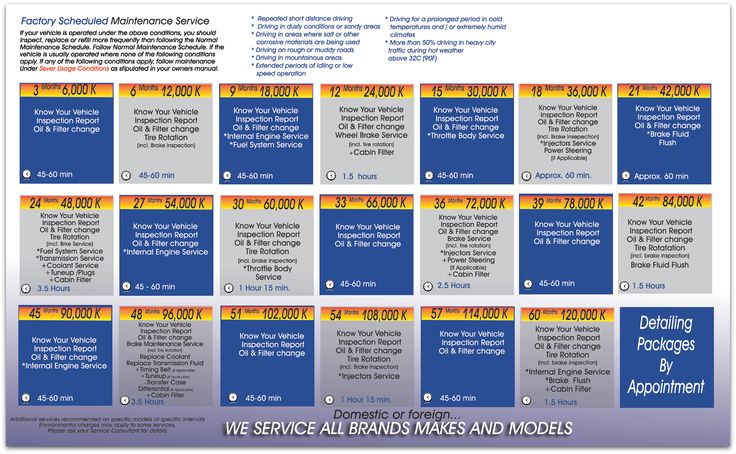 . Let’s take a look at tire rotation patterns recommended by the standardizing body of the tire industry, The Tire and Rim Association, Inc., for all of these possibilities.
. Let’s take a look at tire rotation patterns recommended by the standardizing body of the tire industry, The Tire and Rim Association, Inc., for all of these possibilities.
For vehicles that are 4-wheel, all-wheel, or rear-wheel drive, the rearward cross pattern is recommended. Rear tires are moved to the forward axle and kept on the same side of the vehicle while the front tires are moved to opposite sides of the rear axle.
2. X-PATTERNRecommended for front-wheel drive vehicles such as light-weight trucks and sedans, all tires are moved diagonally, meaning tires are switched from one axle to the opposite as well as being repositioned from one side to the other.
3. FORWARD CROSSThis is the most common pattern for front-wheel drive vehicles. The front axle tires are moved directly back while the rear tires are moved up diagonally to the opposite side of the front axle.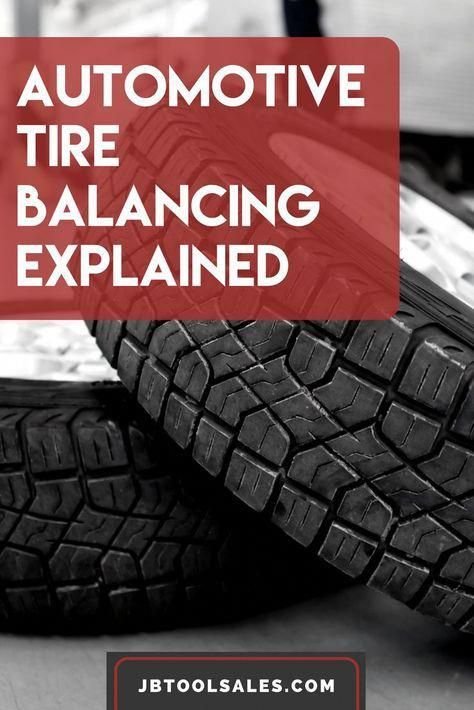
In order to insure that all of the tires on your vehicle have even tread wear, you’ll want to be sure to rotate your full-size spare tire along with the other four. This is especially vital for all-wheel or 4-wheel drive vehicles where even small differences can put undue strain on your car’s drive train.
1. REARWARD CROSS (REAR-WHEEL OR 4-WHEEL DRIVE VEHICLES):Both rear axle tires move directly forward to the front axle while the spare tire moves to the right side of the rear axle. The right front tire moves diagonally back to the left side of the rear axle while the left front tire becomes your new spare tire.
2. FORWARD CROSS (FRONT-WHEEL DRIVE VEHICLES):Rear tires are moved diagonally to opposite sides on the front axle while the right front tire becomes the new spare tire. The spare tire is positioned on the right side of the rear axle while the left tire on the front axle is moved directly back into the left rear position.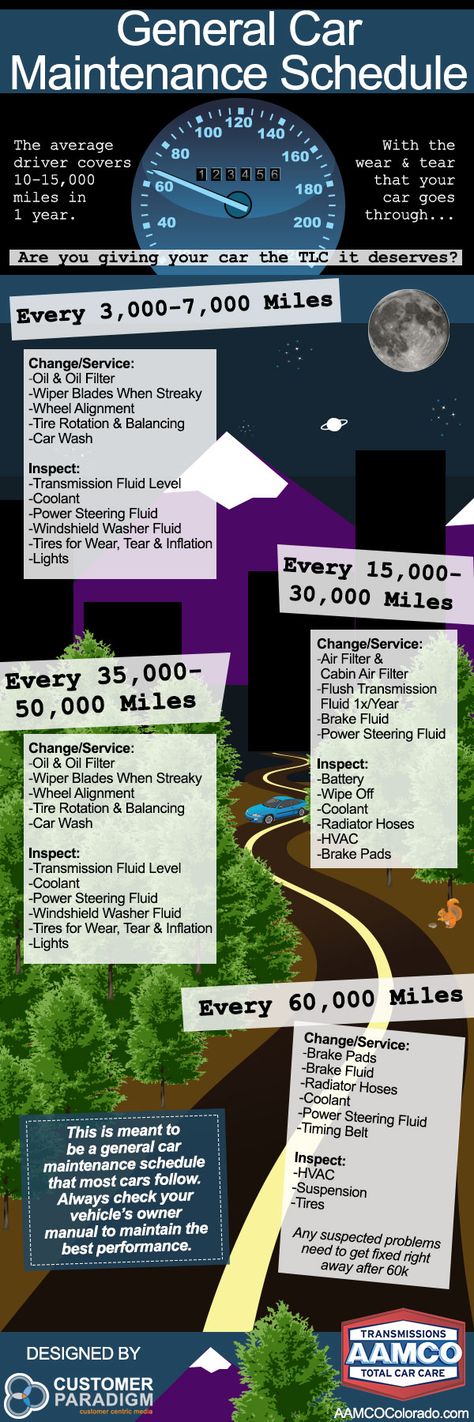
All tires are switched with their same-sized partner and remain on the same axle. The two rear tires switch to the opposite side with one another while the two front tires do the same.
2. FRONT-TO-BACK (FOR DIRECTIONAL TIRES)All tires are moved from one axle to the other but remain on the same side of the vehicle. For example, the front left tire is moved to the left side of the rear axle while the rear left tire is repositioned on the left side of the front axle.
For everything you need to know about buying and maintaining tires, click here.
Quick, name the top two safety features on your car, truck, or SUV. Chances are good that tires didn't factor high among the answers.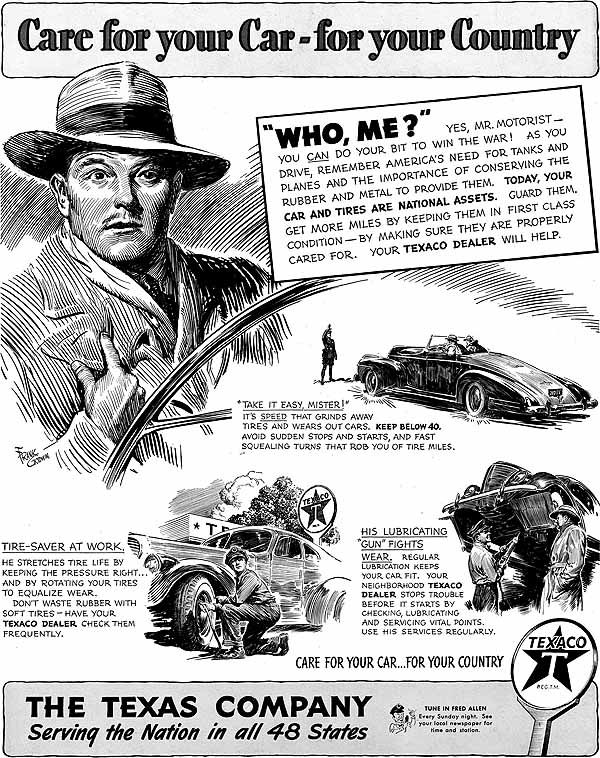 But tires are your vehicle's sole connection to the road. You need to know one of the simplest things you can do to take care of them, so they can take care of you: periodic tire rotation.
But tires are your vehicle's sole connection to the road. You need to know one of the simplest things you can do to take care of them, so they can take care of you: periodic tire rotation.
"Most drivers don't pay attention to their tires," says Matt Edmonds, executive vice president at the Tire Rack, the largest online marketplace for tire sales in the United States. While tires are his business, Edmonds is under no illusion that tire rotation, a vitally important safety check, is going to get pulses racing.
That's because car tires can seem, well, kind of boring. Most drivers tend not to notice them unless they get a flat. Tires don't have the panache of self-driving technology, the excitement of rubber-burning horsepower, or the feel-good factor of automated emergency braking and blind-spot-monitoring systems.
Too bad, because tire rotation is important when it comes to maintaining the performance and safety of your vehicle. Your tires are, quite literally, where the rubber meets the road, as your tires' contact patches with the pavement are in use during every single drive, in all weather conditions. Well-cared-for tires keep you safe.
Your tires are, quite literally, where the rubber meets the road, as your tires' contact patches with the pavement are in use during every single drive, in all weather conditions. Well-cared-for tires keep you safe.
Tire Rack
Buy Now
Tire Rack
Buy Now
Tire Rack
Buy Now
Tire Rack
Buy Now
Depending on whether the vehicle you're driving is front-, rear-, or all-wheel drive, the tires will wear at different rates. The driven wheels have more work to do and often exhibit quicker rates of wear. A front-wheel-drive car, for example, uses its hard-working front wheels to steer, brake, and put the power down to the pavement (all while carrying the added weight of a front-mounted engine and transaxle).
“By rotating your tires, you give the tires a chance to even out their wear and get extended life out of your tires,” Edmonds explains. He recommends having your tires rotated about every 3000 to 5000 miles, or at least every time you go in for an oil change. If your owner's manual states that your car doesn't need new oil that frequently, then plan on a tire rotation at least once every six months.
Rotating your tires evens out the wear and makes them last longer.
Proper rotation not only helps even out wear and extend the life of your tires, it provides the perfect opportunity to make certain all four wheels are in good working order. “As we're coming out of winter and going into spring, it's a good time to inspect the tires' outside and inside shoulder for damage, particularly from potholes,” Edmonds says. It's also a good time to check the condition of your wheel rims, which can be bent by hard impacts with potholes—sometimes only on the inboard side of the rim, where you can't easily see it.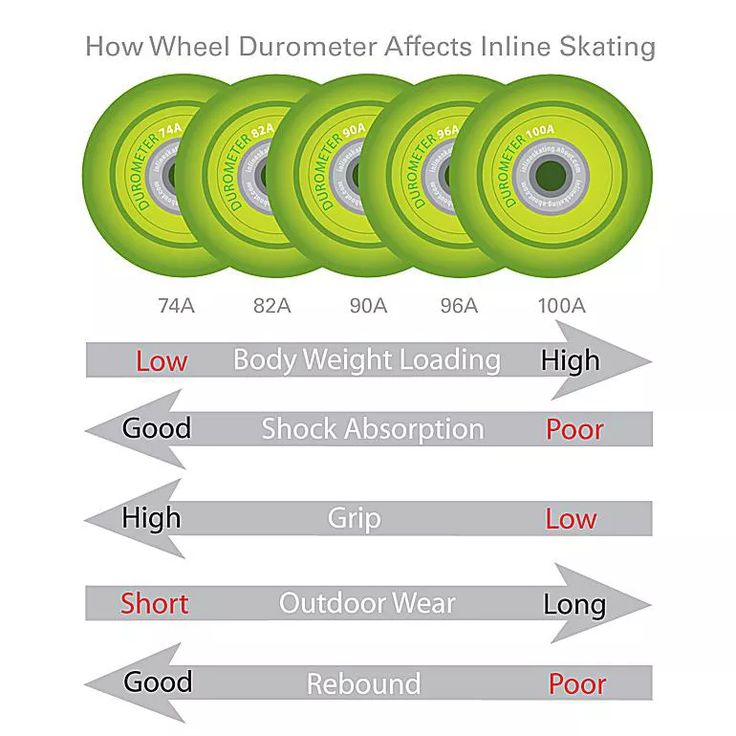
Two common tire problems that might surface during an inspection include cupping and blistering of the sidewall.
Getty Images
Tire cupping, Edmonds explains, is more common in older vehicles with suspension systems that are aging and in need of repair. This issue presents itself via uneven wear patterns in the tread, which, if ignored, could significantly affect a vehicle's ride, steering, and braking ability while also wearing out tires prematurely.
A blistered sidewall—literally, a bulge in the sidewall—might result from slamming into a deep pothole. "A tear might occur inside the tire when that tire gets pinched. The air could then get into the structure of the tire, and you get a blister," Edmonds says. If unseen or left undiagnosed, this problem could result in a flat tire or a blowout that could cause a serious accident. We suffered 10 pothole-related tire failures recently with one of our long-term test cars, a 2017 Jaguar XE, over the course of its 40,000-mile stay, due to Michigan's cratered road surfaces.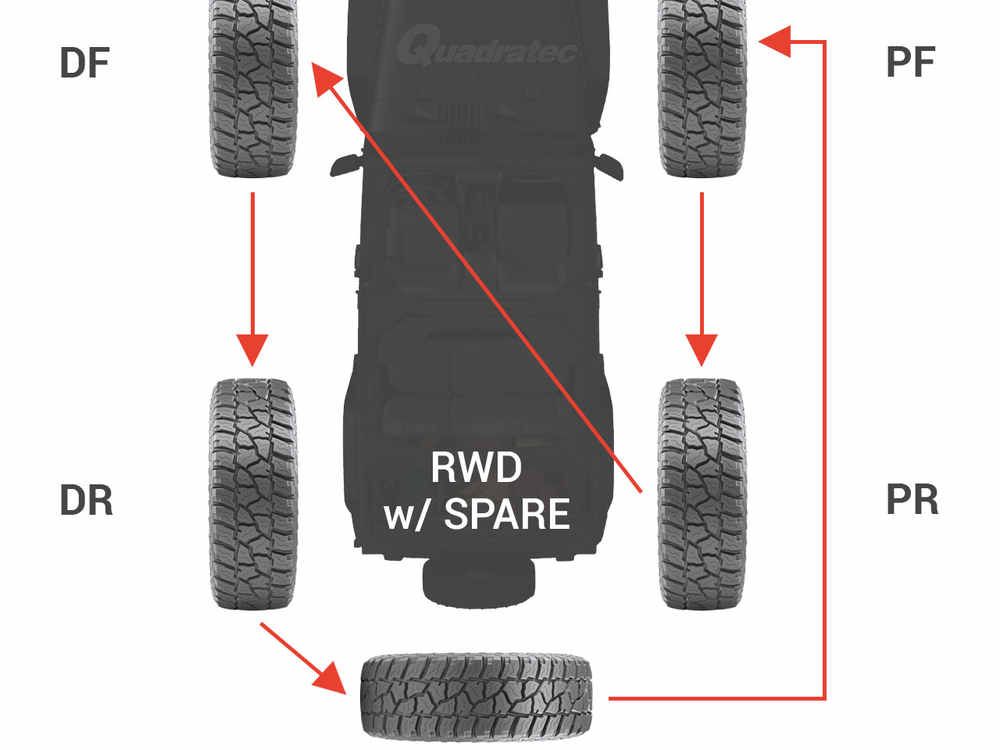
According to the Tire Industry Association, three tire-rotation patterns cover most of today's vehicles, as long as they are fitted with equal-size tires front and rear and those tires are not unidirectional (meaning they have to rotate in only one direction to function properly).
Rotation pattern for front-drive vehicles: Swap the front tires straight to the rear position on the same side. Take the rear tires and move them to the opposite front corner (e.g., the right rear tire gets moved to the left front).
Getty Images
Rotation pattern for rear-drive vehicles: Move the rear tires straight to the front, then move each front tire to the opposite rear corner (for example, move the right front to the left rear).
Rotation pattern for all-wheel-drive vehicles: Crisscross all four tires (move the right front to the left rear, the left front to the right rear, the left rear to the right front, and the right rear to the left front).
By the way, rugged-looking SUVs may be all the rage, but having a vehicle with all-wheel drive doesn't mean you're immune to tire-rotation maintenance. "That is a common misconception," says Edmonds, regarding the idea that all-wheel-drive vehicles automatically have tires that wear more evenly. "All-wheel-drive systems don't always drive all the wheels all the time," he explains, adding that transfer cases and electronically controlled differentials can shift power between the front and rear wheels, depending on the conditions and the drive mode that's been selected. And a vehicle's inherent weight difference between the front and rear can also affect tire wear.
Extra attention needs to be paid when it comes to vehicles with different wheel sizes at the front and rear and those fitted with unidirectional tires—tires that are designed to rotate in one direction only. In many cases, this setup is used on high-performance vehicles, and tire-rotation patterns need to be adjusted to suit.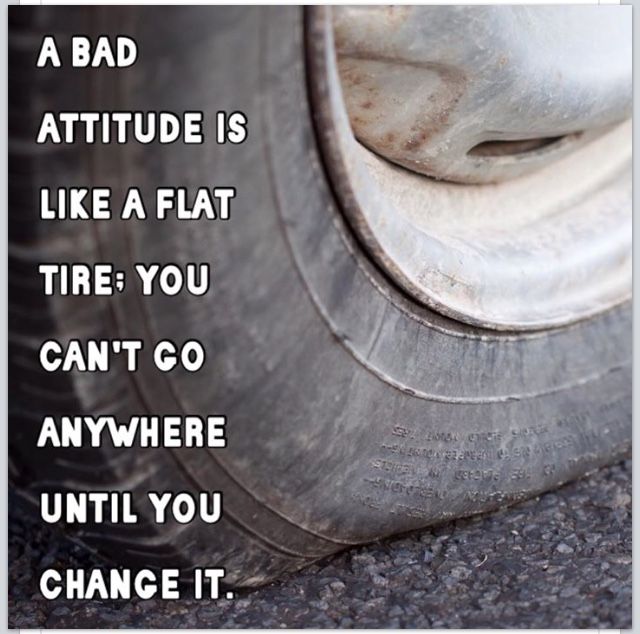 In fact, some of these staggered-tire packages, as they are called, cannot be rotated unless the tires are dismounted and then remounted on the opposite-side wheels. In some cases it may not be worth the time, money, or trouble to rotate the tires.
In fact, some of these staggered-tire packages, as they are called, cannot be rotated unless the tires are dismounted and then remounted on the opposite-side wheels. In some cases it may not be worth the time, money, or trouble to rotate the tires.
If you have any doubts about correct tire rotation, consult the owner's manual, inquire at a dealership, or talk to an expert who is familiar with your vehicle and its tires. But whatever you do, rotate them if possible. At the very least, it'll help your tires last longer and will save you money.
$100 at Home Depot
Now 21% Off
$27 at Amazon
Now 24% Off
$68 at Amazon
$70 at Amazon
This content is imported from OpenWeb. You may be able to find the same content in another format, or you may be able to find more information, at their web site.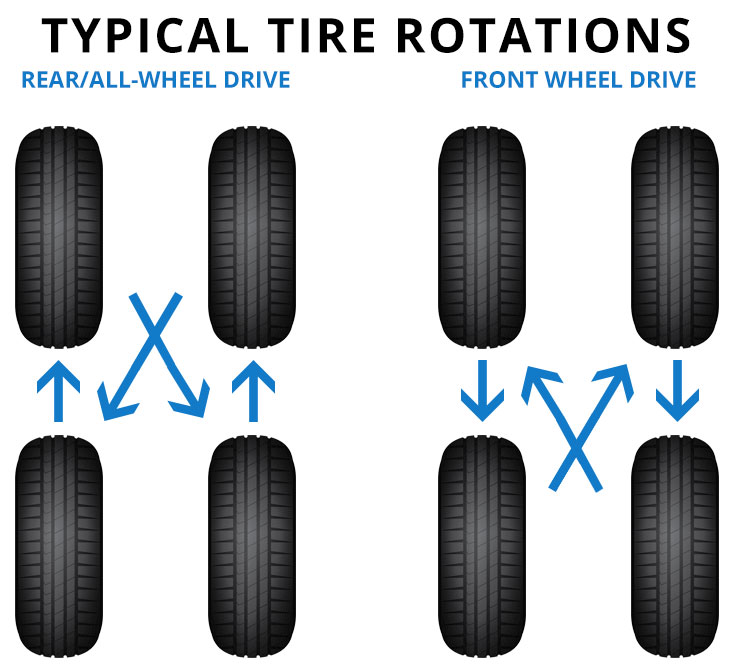
Related materials
7 rubber signals: what the tire says about car problems
How do you know when tires are completely worn out and it's time to change them? Everything is simple. For summer tires, the limit is 1.6 mm of residual tread depth, and for winter (or all-season tires used in winter) - 4 mm. Modern summer tires can travel from 40,000 to 70,000 km, depending on driving style and vehicle characteristics. An average motorist rolls such a mileage on summer tires in 2-3 seasons. Moreover, wear implies not only a decrease in tread depth. For millions of cycles of deformation, the strength of the carcass and its adhesion to the layers of the rubber compound are violated. In short, every 2-3 years you should buy a new set of tires.
In case of irreparable damage to one of the tires and a relatively high total mileage of the kit, it is also worth considering replacing it. Well, or about buying at least a pair of new tires, which, for any type of drive, should be installed on the front axle. We put two tires back - the most decent of the remaining ones.
We put two tires back - the most decent of the remaining ones.
Many motorists drive only a few thousand kilometers a year. This does not mean that the tires will serve you for several decades. According to Russian requirements (GOST 4754-97), the service life of passenger car tires is 5 years from the date of manufacture. And for example, Continental recommends that all car tires (including the spare tire) older than 10 years old should be replaced with new ones. Therefore, with small runs, you can navigate for ten years. The date of manufacture of the tire is indicated on the sidewall. Usually it is an oval with four numbers. The first two are the ordinal number of the week in the year, the last two indicate the year.
Related materials
How to change the car yourself - detailed instructions
Tires should be rotated periodically in accordance with the vehicle manufacturer's recommendations - information on this can be found in the owner's manual.
We can advise you to carefully use the tires and, most importantly, to store them correctly in the off-season. First of all, during storage, it is important to exclude direct sunlight from hitting the tires, which greatly age the rubber. Tires without rims should be placed vertically, and stacked on rims.
And before installing tires on a car at the beginning of the season, evaluate their condition. There should be no cracks in the tread and sidewalls. The tire should not be dry, it should remain rubbery and not look like baked plastic.
Related materials
Driving on badly worn tires - will I be fined or not?
Winter tires have a much shorter life span. They almost always fail due to the wear of the treadmill, because the tread of a new tire is 7–8 mm, and only 3–4 mm remain working height. If the tires are studded, then with such wear there are very few metal elements left, and the tire will not provide adequate safety when driving on a winter road. However, not only spikes, but also Velcro, with such a degree of wear, also lose most of their capabilities.
However, not only spikes, but also Velcro, with such a degree of wear, also lose most of their capabilities.
The real life of winter tires rarely exceeds 30,000 km. "Bald" winter tires without studs can be re-rolled in summer, but their grip on hot road surfaces will be very poor. This must be taken into account, especially when braking.
***
So: tires that have not yet worn out along the tread (that is, up to 1.6 mm tread depth for summer tires, 4 mm for winter tires) are changed either ten years after the date of issue, or when the rubber layer cracks tires or damage.
Our new video
When will the roadster "Krym" - new details
New Russian sedan at the price of Vesta on the tests "Behind the wheel"
When will the Russian electric truck EVM Pro appear? Details known
Did you like the article? Subscribe and you will always be in the know!
Driving in Zen
News smi2. ru
ru
Car tire wear cannot flow evenly : Front tires tend to wear out much faster than rear tires. There are several reasons for this. So, most often the front axle of the car is loaded more than the rear (mostly it accounts for about 60% of the mass of the car). The front tires are subject to wear when maneuvering and also wear due to non-zero settings. In addition, the type of drive of the car affects not least: the drive axle causes the tires to wear out faster. Due to the rotation (rearrangement) of the wheels, it is possible to achieve their more uniform wear and, as a result, life extension .
There is another equally obvious benefit of wheel rotation: Tires with the same depth provide more comfort and safety . This is especially important when it comes to difficult weather conditions. So, for example, most.
How to properly rotate the wheels? It is perhaps better to build on the type of tires installed on your car.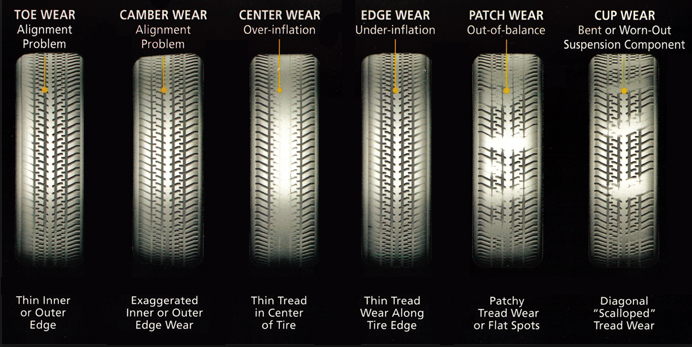
The most popular type of civil tire tread at the moment is asymmetric . This, for example, has most models of the MICHELIN summer line, ranging from economical to sports. When installing asymmetric tires on rims, the front side of the tire must be aligned with the front side of the rim : on the sidewalls for this there are inscriptions Outside and Inside (the outer and inner side of the tire) and there is no arrow for the direction of rotation. The convenience of this type of tread is that the assembled wheels can be interchanged in any way: the outer side of the tire will remain outer anyway . In this case, it is appropriate to use any of the rotation methods. Usually, the most suitable way to rearrange the wheels is indicated in the car's operating instructions, but if there is none on hand, then you can choose one of the methods we have proposed.
The front left wheel is interchangeable with the rear right, and the front right with the rear left. This type of replacement is suitable for any type of vehicle drive and is most preferred for all-wheel drive vehicles.
This type of replacement is suitable for any type of vehicle drive and is most preferred for all-wheel drive vehicles.
The rear wheels are moved to the front axle (the right rear wheel is replaced by the right front wheel, the left rear wheel is replaced by the left front wheel), while the front wheels are installed diagonally in place of the rear wheels (the right front wheel is replaced by the left rear wheel, the left front — in place of the right rear). This method is suitable for cars with rear and all-wheel drive.
The front wheels are installed in place of the rear wheels (the right front wheel is replaced by the right rear wheel, the left front wheel is replaced by the left rear wheel), and the rear wheels, in turn, are moved to the front axle diagonally (the right rear wheel is replaced by the left front wheel). , left rear - in place of the right front). This method is for front wheel drive vehicles.
This type of tread is mainly found on off-road and commercial tires.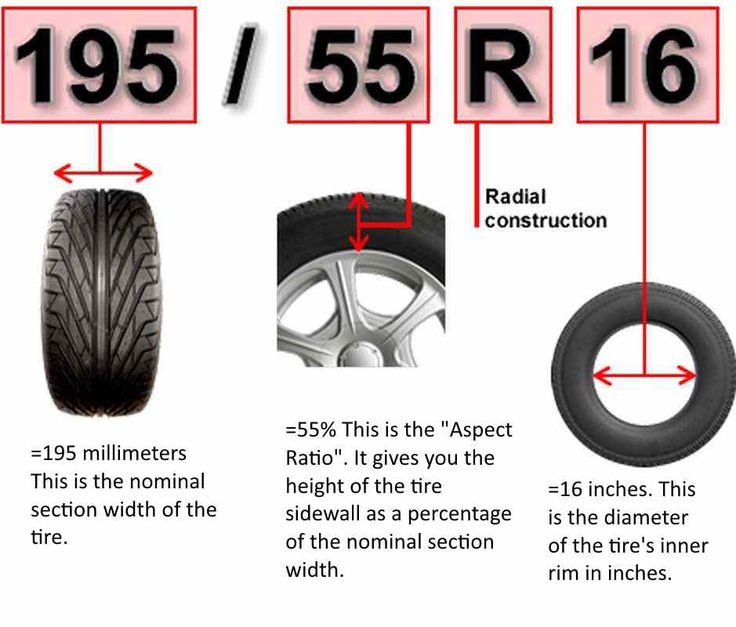 In the MICHELIN line, for example, tire models and. The rotation of tires with a symmetrical tread pattern is exactly the same as the method described above for asymmetric non-directional tires. There is only one difference in the operation of such tires: when assembling the wheels, it is not necessary to take into account the position of the outer and inner sides of the tire.
In the MICHELIN line, for example, tire models and. The rotation of tires with a symmetrical tread pattern is exactly the same as the method described above for asymmetric non-directional tires. There is only one difference in the operation of such tires: when assembling the wheels, it is not necessary to take into account the position of the outer and inner sides of the tire.
Such tires are less and less common in summer tires and almost always in winter: V-shaped tread allows the most effective removal of water from the contact patch. So, in the MICHELIN model range, CrossClimate summer tires and a number of winter tires (, Latitude X-Ice 3, Alpin 5, etc.) have a directional tread pattern. Rotation with directional tires mounted on disks can be done in only one way: by changing the front and rear wheels in places, that is, the front left wheel in place of the rear left, the front right in place of the rear right.
As the name implies, in addition to the outer and inner side, the tire tread pattern has a directionality.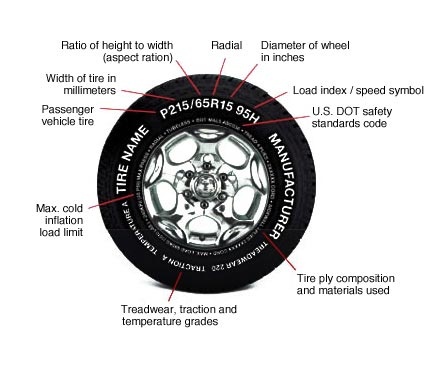 This type of tire is used only in motorsport due to the inconvenience of use, high cost and lack of tangible benefits for civilian use. Rotation with such tires is carried out in the same way as in the case of symmetrical directional tires: the front and rear wheels of each side of the car change places with each other.
This type of tire is used only in motorsport due to the inconvenience of use, high cost and lack of tangible benefits for civilian use. Rotation with such tires is carried out in the same way as in the case of symmetrical directional tires: the front and rear wheels of each side of the car change places with each other.
Many sports cars are sometimes fitted with wheels of different sizes: the rear tires are usually wider and larger in diameter. If the tires have an asymmetric non-directional tread pattern, then the wheels on each of the axles can be interchanged, but if we are dealing with directional tires, then alas, the rotation of such wheels without tire fitting is impossible.
This type of rotation allows extend the life of the wheels by about 20% , but in reality this method is almost never used: many modern cars either do not have a spare wheel in the trunk at all, or a small-sized “stowaway” is used as its quality. And even if your car is equipped with a full-size spare wheel, in practice it most often differs in either tire model or wheel type. However, if the spare tire is completely identical to the wheels installed on the car, then rotation in this case can be extremely useful. For ease of changing wheels, the type of tread pattern should be either asymmetric non-directional or symmetrical non-directional. The rotation process in this case is no longer as obvious as in the previous methods.
And even if your car is equipped with a full-size spare wheel, in practice it most often differs in either tire model or wheel type. However, if the spare tire is completely identical to the wheels installed on the car, then rotation in this case can be extremely useful. For ease of changing wheels, the type of tread pattern should be either asymmetric non-directional or symmetrical non-directional. The rotation process in this case is no longer as obvious as in the previous methods.
The front right wheel is removed in place of the spare tire, the spare wheel is installed in place of the rear right wheel, the rear right wheel in place of the front left wheel, the front left wheel in place of the rear left wheel, the rear left wheel in place of the front right wheel.
The spare wheel is installed in place of the rear right wheel, the rear right in place of the front right, the front right in place of the rear left, the rear left in place of the front left, and the front left wheel, in turn, is removed in place of the spare tire.
The more often you change the wheels, the more evenly the tires will wear . But, since it is quite troublesome to do this too often, experts advise changing the wheels in places during the periodic one - when the car is somehow lifted onto the lift. As a rule, runs in 8-10 thousand km is enough for the next wheel swap: in this simple way, you can not only extend the life of your tires with , but also to maintain the safety of movement at the proper level.
A brand new set of tires can last 80,000 kilometers or more, however, this applies to ideal working and road conditions. But some of these conditions we can create ourselves. Just a couple of simple rules, and the life of tires can be easily extended by 30-40 thousand kilometers.
Of course, many factors affect the life of your tires. This is the driving style, and the class of the car, its technical condition, the type of tires themselves.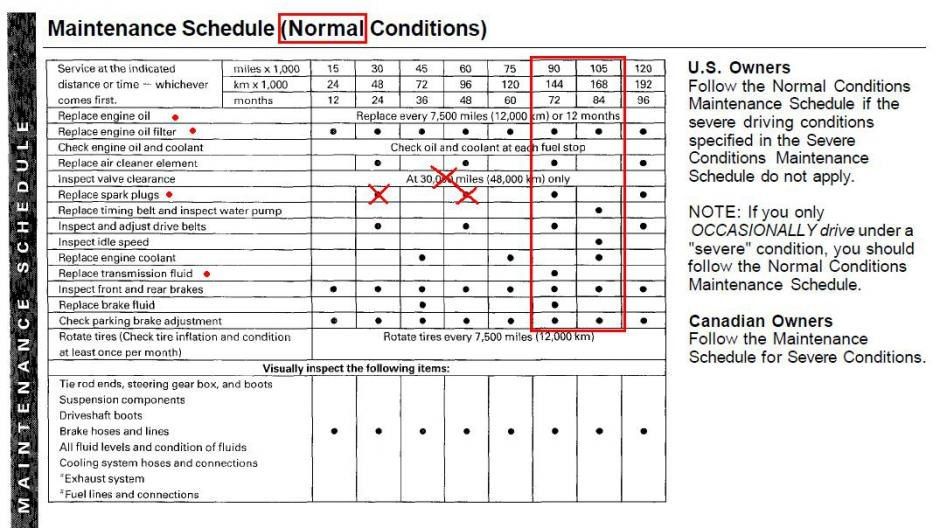 And, of course, the tire life of a neat summer resident, who drives a car a couple of times a year, and that of an aggressive street racer, who constantly blows smoke at the start, will be completely different. An important factor affecting the lifespan of rubber is the degree of wear of its elements, whether it be ball bearings, bushings, etc. It is also necessary to set the correct camber, maintain optimal tire pressure.
And, of course, the tire life of a neat summer resident, who drives a car a couple of times a year, and that of an aggressive street racer, who constantly blows smoke at the start, will be completely different. An important factor affecting the lifespan of rubber is the degree of wear of its elements, whether it be ball bearings, bushings, etc. It is also necessary to set the correct camber, maintain optimal tire pressure.
Another way to extend the life of tires is swapping wheels. Previously, experienced drivers often used this technique, for many it was the rule, but today it is almost forgotten about it. How does changing tires help? Quite simply, different wheels in a car are subjected to different loads, which, in turn, leads to clear differences in the structure and degree of tire wear. For example, the front tires carry most of the mass of the car, since in the vast majority of cars the heavy engine is located in front. The load increases even more at, up to 80 percent of the weight falls on them during heavy braking.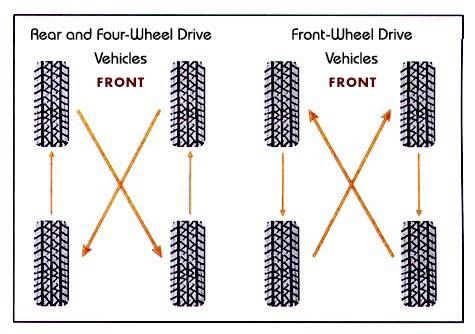 Then, the front wheels are constantly turning, which cannot but affect their accelerated wear.
Then, the front wheels are constantly turning, which cannot but affect their accelerated wear.
The wear pattern of the front and rear tires is different, on the front the edges of the tread are worn off, while the rear tires lose the middle part. Timely rotation of the wheels will make it possible to make this wear more uniform: the rear tires will begin to wear out on the sidewalls, while the front tires will wear out flat. Of course, you can just change to new front tires if you have enough money to spare, but it's easier to just swap tires, extending their life by a factor of one and a half. Moreover, tire manufacturers themselves advise rearranging tires every six months or every ten thousand kilometers. And in order to do this, you don’t have to take separate additional actions, because every six months we change our cars from summer to winter tires and back. You just need to swap them.
The rearrangement scheme may be different, but it is correct to do it as follows: put the rear tires forward in the same order as they were, that is, left to left, and right to right. The front tires should be placed crosswise on the rear axle, that is, we put the left front on the right rear side, we do the same with the right front.
The front tires should be placed crosswise on the rear axle, that is, we put the left front on the right rear side, we do the same with the right front.
But there is one significant nuance here - an asymmetric tread pattern. If you have such tires, then the rearrangement is done without changing the sides. On powerful cars or on sports cars, wheels of different sizes are often installed, in which case the tires are transferred only along the sides, from right to left. And before each shift, carefully study the markings of your tires.
Tire Rotation Chart
Wheel rotation is critical when it comes to extending the life of the tires you have purchased. During operation under various driving conditions, your tires are subject to uneven wear. Depending on your driving style, it's wise to swap your tires every 6,000 miles (9,700 km), around every second oil change. Read on to find out how to add this inexpensive and easy money-saving method to your Mechanic arsenal.
Part 1
Car lifting
Take the jack. Your vehicle is equipped with a jack so you can change one wheel at a time. But in order to swap all the wheels, you need to lift the entire car off the ground. The easiest and cheapest way to do this is to get a set of props, which cost about $30. DO NOT try to do this with multiple jacks.
Find a surface with a suitable working level. You can prevent the risk of the lifted vehicle becoming unstable by working on a level surface. Apply the parking brake before starting work, and block any wheels you have not jacked up so that the machine does not roll forward or backward while you work.

Remove the caps and loosen the mounting bolts. With your vehicle still on the ground, use the cross wheel wrench and remove the caps to get to the mounting bolts. Then, using a wrench, loosen the bolts with which the wheel is bolted to the axle. DO NOT REMOVE the bolts, just loosen them a little so that they can be easily removed when you raise the machine.
Raise the machine. Use a jack to raise each corner of the machine and then install the stands. Read the instructions to install them correctly.
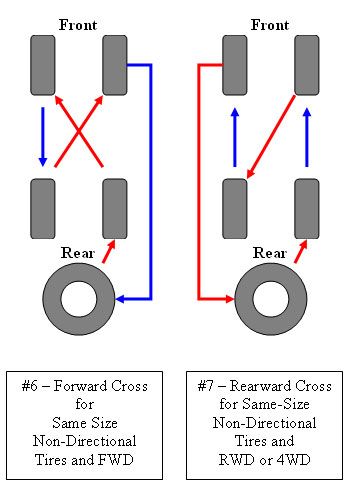
Part 2
Wheel swapCheck the tread pattern on the tires. Wheels are directional and non-directional. Directional tires have a strictly directional tread pattern, usually with grooves designed to channel water and sand outwards to improve handling. For this reason, directional tires on the driver's side and tires on the passenger's side must not be interchanged and vice versa. Non-directional tires look the same, and it's perfectly safe to swap the driver's side wheels for the passenger side wheels.
 With this option, you can be sure that you will do a full tire rotation in two sets and ensure the longest possible tire life.
With this option, you can be sure that you will do a full tire rotation in two sets and ensure the longest possible tire life. Remove the mounting bolts from the first wheel you lifted and remove it. Roll the wheel to a new location. Keep an eye on the bolts and keep them close to the axle they were removed from. The threads should be the same, but in general their location should be tied to the car and not to the wheel.
Change the tires correctly according to the diagram. If you have raised the machine completely, simply reposition the wheels, place them on the hubs and hand-tighten the mounting bolts.
 Then move that front wheel to the back of the car on the passenger side, and so on. Continue to move around the car, swapping the wheels in the appropriate order (according to the diagram).
Then move that front wheel to the back of the car on the passenger side, and so on. Continue to move around the car, swapping the wheels in the appropriate order (according to the diagram). Lower the machine. Using a jack, raise each side of the vehicle until the supports can be safely removed and then lower the vehicle. Before doing this, make sure that the wheels are sufficiently fastened. You should be able to rock the wheel back and forth.
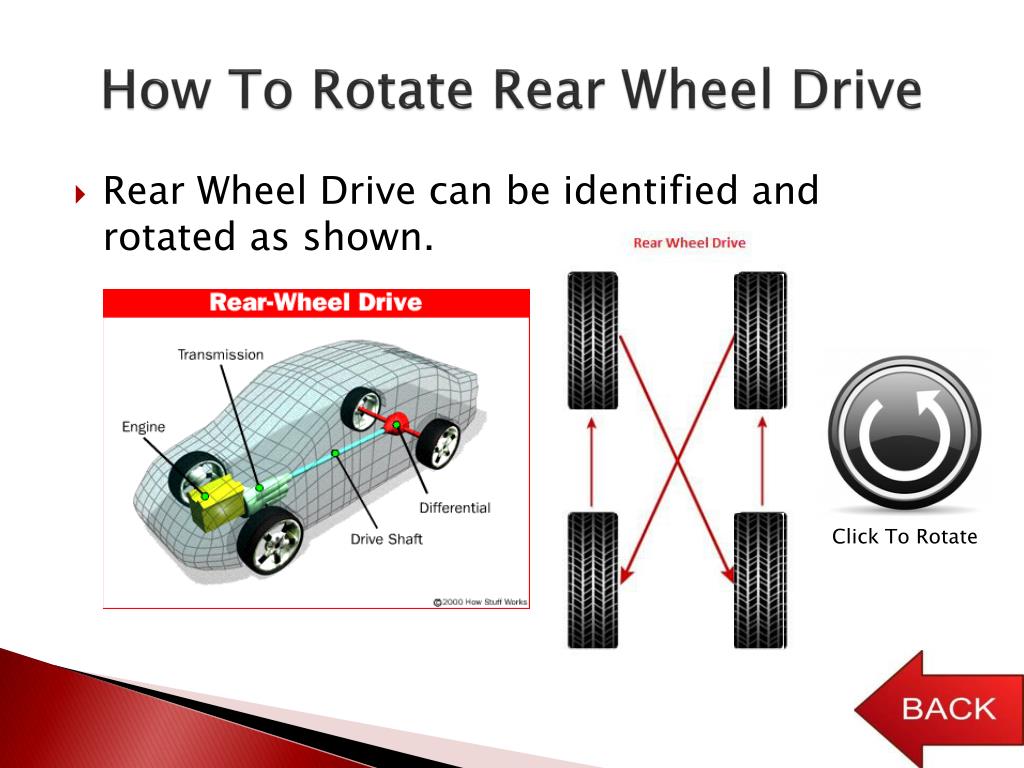 Excessively tight tightening of the tips leads to the fact that it is extremely difficult for a person of average build and height to unscrew them.
Excessively tight tightening of the tips leads to the fact that it is extremely difficult for a person of average build and height to unscrew them. Wheels should be rotated regularly, following either the vehicle owner's manual or tire industry regulations. Proper wheel alignment helps to make the longitudinal and lateral wear of the tires more even, as well as improve ride comfort and reduce noise levels. Minimal differences in the longitudinal wear of the tire tread, which may occur after periodic wheel replacement every 5,000 - 8,000 km, do not affect the resistance to aquaplaning, and the wheels can be rearranged further.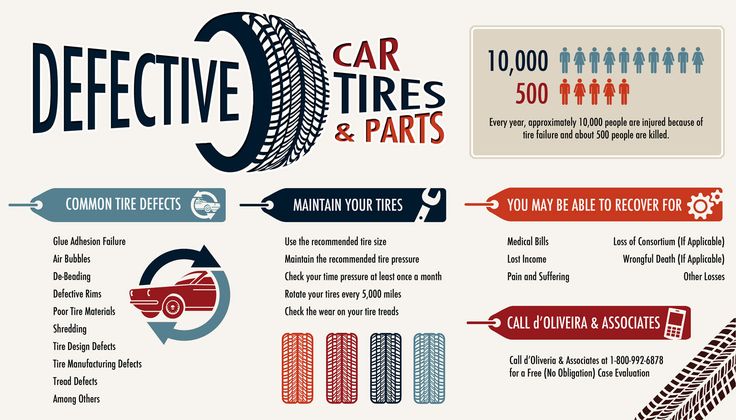 In this case, any differences in wear actually mean that repositioning should be done at shorter intervals.
In this case, any differences in wear actually mean that repositioning should be done at shorter intervals.
Changing wheels is advantageous for several reasons. When performed as recommended, it can improve handling and traction, and reduce uneven wear.
There are warranties that are valid only if the wheels are correctly rotated. Experts recommend changing wheels every 5,000 to 8,000 km, even if there are no signs of wear. Often the shift can be done at the same time as changing the oil while the car is on a lift. This is a good time to check the tires for damage, remove stones and other foreign objects, determine the wear uniformity by measuring the tread depth and, of course, check the pressure level.
Tires on the front axle of a car are significantly different from the tires on the rear axle in terms of tasks performed. At the same time, tires on a front-wheel drive car operate in significantly different conditions than on a rear-wheel drive car. Whichever wheel the tire is mounted on, there may be different wear types and rates anyway.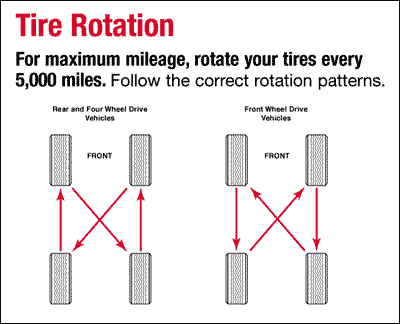 Therefore, it is best to have all four tires wear equally because when wear reduces tread depth, it allows all four tires to respond faster to steering inputs, maintain handling characteristics, and help improve cornering grip.
Therefore, it is best to have all four tires wear equally because when wear reduces tread depth, it allows all four tires to respond faster to steering inputs, maintain handling characteristics, and help improve cornering grip.
If all tires wear the same, you can buy a new set instead of buying tires in pairs. If you change the entire set, the original handling characteristics are preserved. In addition, manufacturers are constantly releasing new, improved tire models, and if you put in a new set, you can improve the car's handling, instead of looking for tires of the previous generation. Drivers who drive an average of 19 per year000 - 24,000 km, two of the three wheel changes will be carried out during the tire change before and after winter. All that remains for them to do is rearrange the wheels again in July.
How exactly should the wheels be changed? There are three traditional methods suitable for most vehicles (equipped with tires and rims of the same size). The second method can be used as an alternative to the first and third.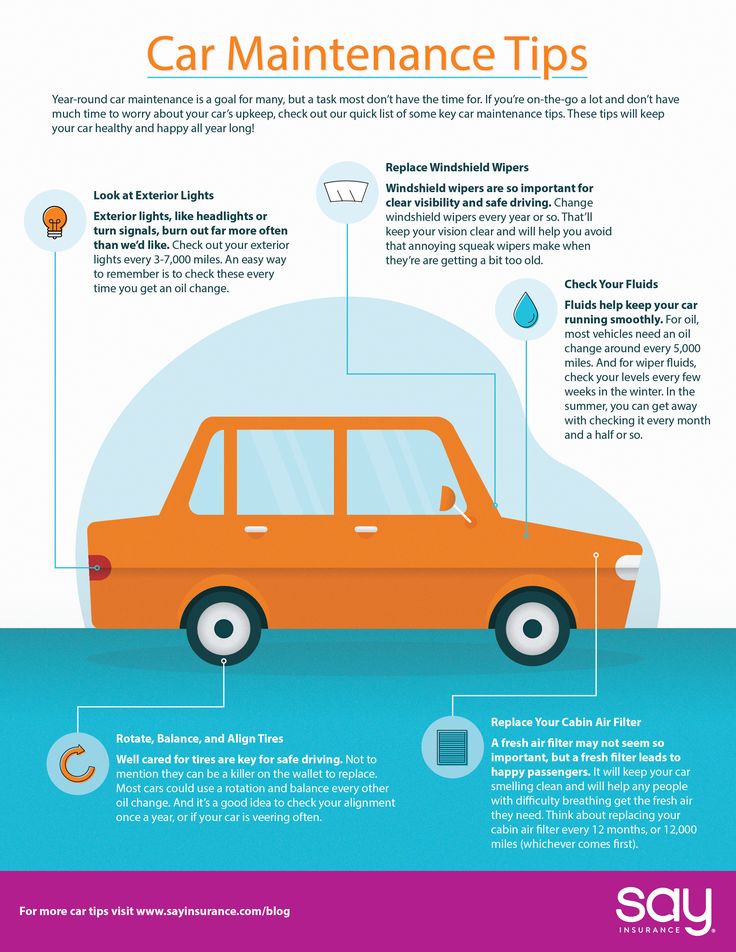
Wheel conversion scheme:
There are also two additional ways. The fourth method is suitable for cars with the same tire and wheel sizes, and the fifth for cars with different size tires on the front and rear axles.
Although many vehicles are equipped with a spare tire that is smaller than the standard tyre, if the spare wheel is the same size as the others, it must be used when changing. Follow the vehicle manufacturer's instructions, or if they are not available, always fit a spare on the right rear wheel. One of the other tires, according to the diagram, put in the trunk and use as a spare until the next swap.
Regular wheel rotation will ensure that all five tires wear evenly throughout their life. In addition, correct repositioning is important when a puncture causes a spare wheel to be fitted and used with three partially worn tyres.
Many of us are constantly looking for ways to save money. And you don’t need to go far for this: one of them is to maintain your own car yourself. Plus, if you don't take good care of your car's tires, they will cost you dearly.
Plus, if you don't take good care of your car's tires, they will cost you dearly.
The easiest way to prolong the life of your tires is to change them regularly. Some car owners never do this, others turn to specialists. You can easily save your money by doing this work yourself. We'll tell you how.
Front and rear tires wear differently. For example, the front tires carry more than 60% of your car's weight and therefore wear faster than the rear tires. In addition, cornering wears the front tires at different rates. When driving on the right, we tend to turn left faster than we turn right. This puts more stress on the right front tire, causing it to wear faster than the left. After driving thousands of miles, you will eventually find uneven tread wear.
Tire rotation equalizes this natural wear. By doing this regularly, you will ensure a smoother and safer ride. And more importantly, you will save money in the long run because your tires will last longer. And in general, this is a truly masculine occupation, which should not be abandoned.
And in general, this is a truly masculine occupation, which should not be abandoned.
Please consult your vehicle owner's manual. There you will surely find the recommended tire rotation pattern. Most manufacturers recommend changing tires every 5,000-10,000 km. Do this every time you change your engine oil, for example. So it's easier to remember.
Before we begin to unscrew the wheel nuts, we must determine in which scheme we will rearrange the tires.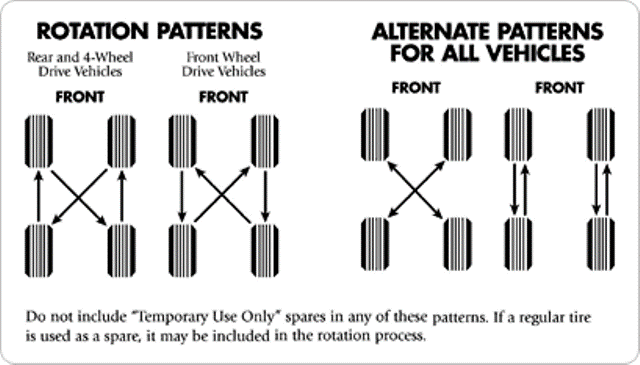 How you rotate your tires depends on several factors, but what you should pay the most attention to is whether your vehicle has directional or non-directional tires.
How you rotate your tires depends on several factors, but what you should pay the most attention to is whether your vehicle has directional or non-directional tires.
These tires have a unidirectional tread pattern that is optimized for wheel rotation in a particular direction. The arrow and the word "ROTATION" on the sidewall indicate the direction of rotation, and the installation of such tires on the wheel is made in accordance with these requirements.
To swap directional tires, simply swap front right and rear right tires, and front left and rear left. Like this:
Swapping non-directional tires. The tread pattern on non-directional tires allows you to install the tire in any way (either side), since it does not have a direction of rotation.
For rear-wheel drive vehicles, move the front tires to opposite sides of the vehicle's rear axle: front left becomes rear right and front right becomes rear left. The rear tires simply move forward without changing sides.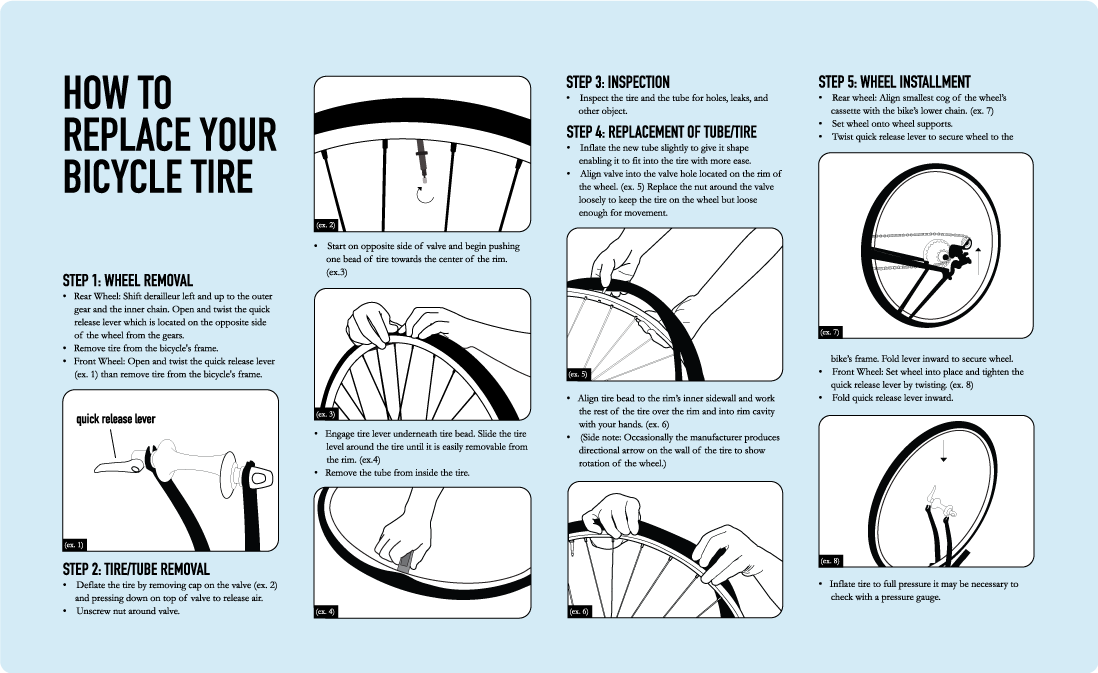 Here's what it looks like:
Here's what it looks like:
For front wheel drive vehicles, do the opposite. Move the rear tires to opposite sides of the front axle and put the front tires on the rear axle without changing sides:
Some older car manuals recommend using a spare tire to give one of the tires a break. But the problem is that the vast majority of today's spare tires are not designed for long drives. They are often smaller, lighter in construction and have shallower tread depth. Their main purpose is to help you get to the auto repair shop, where you will install the original tire.
However, some vehicles are still fitted with the appropriate full spare tires. This is usually the case with SUVs. If you have such a spare tire, then it will be a good idea to put it into operation from time to time. Here is the chart for this swap:
 It is not necessary to remove them completely yet, but when the car is raised, it will be much easier to unscrew them.
It is not necessary to remove them completely yet, but when the car is raised, it will be much easier to unscrew them. 